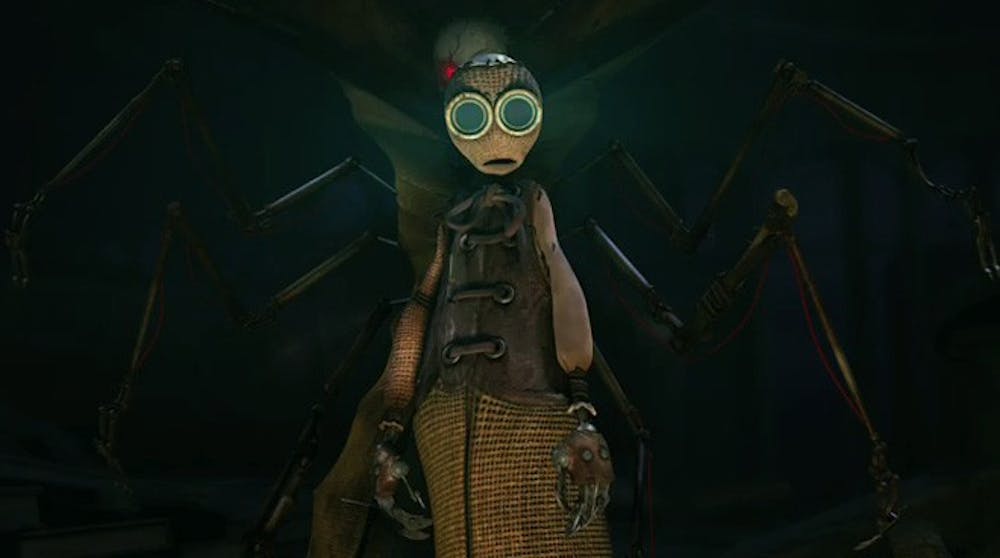"Our blind pursuit of technology only sped us quicker to our doom."
So speaks No. 1, a pontiff-dressed ragdoll and one of a collection of burlap heroes at the center of director Shane Acker's post-apocalyptic tale, "9." Remarkably, that line of dialogue, one that feels lifted from the science fiction pantheon ("The Terminator," "Mad Max" and Terry Gilliam come to mind), works better as a commentary on the state of Hollywood filmmaking than any great insight into humanity.
Yes, "9" is another narrative "raking over" that familiar scenario: What would happen after the end of the world? However, thanks to the creative trio of Acker and producers Tim Burton and Timur Bekmambetov, this familiar story has been re-fashioned through the visual guise of computer animation (wait, didn't anyone see "Wall-E"?). And although "9" is visually stunning, it is a movie so caught up in a desire to provide groundbreaking visuals, it somehow forgets to tell a coherent or worthwhile story.
The film chronicles the journey of the titular hero No. 9 (voiced by Elijah Wood), a kind of mechanized ragdoll, who at the film's onset, is awoken to the grim surroundings of an industrial wasteland. Along with the aptly named No. 1, No. 2, No. 5, and No. 6 (voiced by Christopher Plummer, Martin Landau, John C. Reilly and Crispin Glover) our pack of hodge-podge heroes hope to discover the clues that
link them to their anonymous maker.
This is a world riddled with fear, and unlike many of its filmic predecessors, "9" appears to argue for apathy over agency after the apocalypse. As a result, we are left with a kind of bizarre rendition of the nuclear family, hiding out in a deserted cathedral, waiting for the machines to forget about them. This seems like an interesting setup until No. 9 (I'd like to call him "super-burlap"), comes to save the day, ridiculing the group for having such human impulses as fear. Suddenly this feels like an animated version of the latest "Terminator" movie.
The film's setting, aided by a wonderfully dismal palette of grays, browns and radioactive greens, looks eerily akin to a shelled-out, post-war Europe (the back-story even goes as far as alluding to "iron fists" and "comrades"). But alas, hopes of any kind of edifying allegory are soon dashed in what amounts to a recklessly plotted chase movie.
Acker's film completely lacks any real narrative drive. Questions pertaining to the origin of No. 9 and his band of mannequins are lazily treated through back-story and flashback, while the "shock and awe" revelation you feel the film has been building to ... well, isn't much of a revelation. The story rambles on from action set-piece to action set-piece until it reaches an ending that some critics have applauded for its ambiguity. The ending isn't so much a brave exercise in storytelling as a hackneyed conclusion to a movie that is structurally inept. This is a film that has trouble sustaining itself for its 79-minute running time and I wonder whether Acker would have been better off leaving "9" in its original format (an Oscar-nominated short). Truthfully, "9" does feel like a stretched-out short.
It might be useful to point out that Acker's film is just the latest in a string of releases to bear the marquee "presented by." A similar gimmick was recently seen in Peter Jackson's presentation of director Neill Blomkamp's startling debut, "District 9" (I am still confused as to what "presented by" means in terms of a film's creative impetus ...). In "District 9," Jackson's influence is clearly present as the film
works on some of the director's trademarks (films including the director's "King Kong" re-make and his "Lord of the Rings" trilogy come to mind). So one might assume that "9" shares the sensibilities of its presenter, Tim Burton. Unfortunately, this is not the case. Although there are touches of Burton's penchant for the macabre, his darkly comic sense of irony has gone completely missing. Truthfully, "9" never reaches the soaring greatness of Burton's and director Henry Selick's stop-motion classic, "The Nightmare Before Christmas."
In its defense, "9" does have its moments, the evidence of which is found in a memorable sequence towards the end of the film. After the protagonists think they have destroyed their machine-like archnemesis, they stumble across a record of Judy Garland's "Somewhere over the Rainbow" amidst the nuclear rubble. In perhaps the film's first genuine moment, No. 9 and his friends are completely wonderstruck by the majesty of the melody in the face of the destruction that surrounds them. The irony here, as the music plays against images of a doomsday inferno, is the only Burton-esque moment in the entire film. No. 9's brief fascination with the duality of humanity, the same fascination that enthralls Wall-E as he views "Hello Dolly," is a notion the film hardly acknowledges until it quite literally loses the plot.
Contact Collegian reporter Greg Montine at greg.montine@richmond.edu
Enjoy what you're reading?
Signup for our newsletter
Support independent student media
You can make a tax-deductible donation by clicking the button below, which takes you to our secure PayPal account. The page is set up to receive contributions in whatever amount you designate. We look forward to using the money we raise to further our mission of providing honest and accurate information to students, faculty, staff, alumni and others in the general public.
Donate Now



